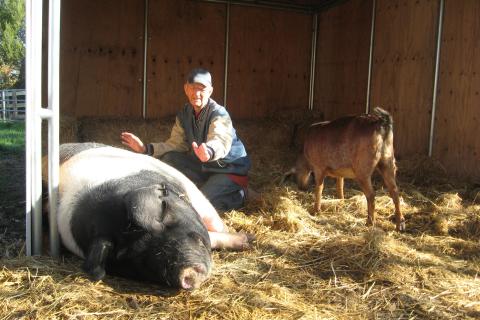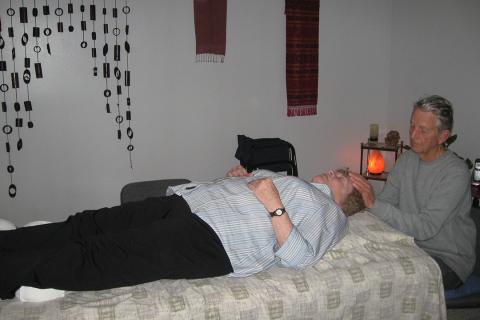
At the age of 91, and after decades of delivering reiki to underserved and forgotten communities, ABMP member Bill Stevens announced his retirement. Stevens was featured in the November/December 2024 issue of Massage & Bodywork magazine in “Faces of Bodywork.”
Below, learn more about his practice:
• New Rochelle, New York
• Specializes in reiki for animals and end-of-life care
• Recently retired owner, Evolutionary Reiki; evolutionaryreiki.com/
Massage and Bodywork: Tell us about yourself and where your path started?
Bill Stevens: I was born in Boston, Massachusetts, in 1933—the fourth of five children. The Depression changed our lives quite dramatically, and we moved 12 times, living in six cities. I attended six different schools through the end of high school. I was taught by the [Congregation of] Christian Brothers in high school and was drawn to join their congregation at the age of 17 upon graduation.
After my formation training and completing my studies at Iona University in New Rochelle, New York, I was to teach for 24 years in their schools before making a major lifechanging decision to commence a nine-month Clinical Pastoral Education training to become a hospital chaplain.
M&B: Eventually your work leads you to the AIDS community. How did that transition happen?
BS: In the 1980s, people who were diagnosed with AIDS began to come into the hospital to die. This is what led me to another major transition in my life. I created a nonprofit organization named Chrysalis Ministry to reach out to this community.
I wanted to offer the AIDS community a modality to make a difference in their lives. In 1990, I did a year of massage studies in Princeton, New Jersey, at the Health Choices Clinic, directed by Kristina Shaw. Shortly after, I heard of a chaplain in a San Francisco Hospital offering reiki to AIDS patients. Then I found a Reiki Master in New Jersey, Penny Gnesin, and completed a Level 1 Reiki weekend in 1991. I began to incorporate this practice into my ministry as well.
I used to go to AIDS clinics in hospitals, and when the patients came in to see their doctor, they could, before or after their appointment, receive a massage or reiki session. I also did this during support groups at different venues. A person could leave the session and step in for a half-hour treatment. At one of these sessions, I gave reiki to a man who had mental health issues and was struggling with drug addiction as well. At the end of the session, he was in a very different state, not attributable to any substance he had taken. He told me he had had the most spiritual experience he ever experienced. He was visibly affected. Reiki did that . . . it brought people to a different place—a peaceful, quiet, deep place. Quite profound.
I also used to visit AIDS patients who were at the end of life. One particular person I remember was in pain when I was visiting, and I offered reiki to him. After a few minutes, he told me that the pain had dissipated. I was as surprised as he was. It helped me realize that it is not about my experience but what the person is experiencing that counts. Later, whenever I walked into the room, he would say, “Here comes my pain medication.” I often thought the nurses must have thought I was sneaking something into him.
I worked with the AIDS community for 12 years, offering massage and reiki, wherever the patient was—at their home, in the hospital, in clinics while they were waiting for their appointments, and during retreat programs.
M&B: We know you trained with the Zen Hospice Project in their End-of-Life Counselor Program in San Francisco. How did that transform your work and can you share some of those experiences?

BS: I named my reiki practice Evolutionary Reiki, because I was constantly evolving in my understanding of this practice. I was privileged to have had wonderful teachers show up in my life and help me on my spiritual path. As I continued to keep in touch with them and their teachings, my reiki practice and massage practice deepened.
Thinking about my time working in hospice, I recall the story of Jim. One day, a nurse called me to tell me a man was at the end of his life and had a lot of anxiety and asked if I would come to give him a treatment. I had minimal conversation with him but took the time to tell him what I would do. It did not take long before he went into a deep reiki slumber. The next day, the nurse called to tell me that his wife had called to say he would like me to return. I once again offered reiki to him, and he went into a deep reiki slumber. The nurse called me the next day and told me he had died 12 hours after the session, and before dying, he had reconciled with his son and had died peacefully, surrounded by lots of love from his family.
And then there was Jack. Jack was a construction worker who had a rough exterior. He was a Roman Catholic but had refused to see the chaplain. He had cancer of the esophagus and was a very quiet, reserved man. The nurse asked if I would come in to give him reiki.
We had minimal conversation. I offered him reiki as he lay on the couch. He did not seem to have any external reaction to the session. I returned for a second session the next week, and he was much more open to receiving it. He went into a deep sleep shortly after I began. The next day, the nurse called and told me he was a changed man. He said he had never felt so good in his life. He was so happy I had given him the treatment. It took him to another place—a peaceful, calm place—and he felt so much better for it. The fear and anxiety he had exhibited earlier in the week were no longer there. He asked for a priest and received the last sacraments. I gave him one more treatment before he died a few days later.
My rational mind always seeks an explanation. But the bottom line seems to be, over and over again, that this spiritual energy travels to where it is most needed on a physical, emotional, spiritual, or mental level for the person’s highest good. I do nothing. The person does nothing.
M&B: A large portion of your career centered on reiki for animals. Would you tell us more about that?
BS: One of the things about reiki that is so wonderful for animals is that you don’t need physical contact or touch, and it is gentle and noninvasive. So, when we talk about animals who are sick, have been traumatized or abused, or have some issues that they need healing from, reiki can address all these issues—physical, mental, emotional, spiritual—whatever the issues are. Reiki can address them all from a gentle, noninvasive space.
Let me tell you about Benz. One day, when I went into an SPCA shelter, I met a volunteer fostering a recently rescued dog named Benz, who came from one of the southern states. It was quite a challenge. He had a lot of aggressive behavior toward the male gender, which made it difficult for him to be adopted. I worked together for several months with the volunteer in the shelter and at her home, where she brought him for brief periods. When I first went outside his cage at the shelter, he was very aggressive. As I sat quietly in my meditation and offered reiki, he would slowly back off and stretch out on his mat into a restful place.
When I first went to the volunteer’s home and sat in meditation to offer Benz reiki, he would pace around the room and initially go up to the second floor to stretch out and relax. After a few sessions, he would go to a nearby couch and fall into deep reiki slumbers during the sessions. The volunteer and I were optimistic, but Benz continued to be quite aggressive toward her husband. After some scary incidents, he was brought back to the shelter, and it was determined he was not adoptable and needed to be put down.
I asked if I could give him some private reiki sessions before this happened. The person in charge found a supply closet that would provide us privacy. She said she wanted to be with me and would bring some work with her while I was offering reiki. I offered reiki to Benz the last two days before he was euthanized. They were two of the most powerful experiences I had had with him. He was so receptive. At one point in the session, he approached me as I sat on my cushion, stretched out before me, and stayed there for an extended period in a deep reiki slumber. It was the first time he had ever done that. The person in charge never did any work—she was totally mesmerized by what was happening.
I was out of town when they put Benz down, but they did it very sensitively. They invited the volunteer to come and be with him and hold him while he was given a Big Mac . . . and they euthanized him. I later did a memorial service for the volunteer and offered her reiki during that time.
M&B: And now, having just retired, how is reiki still a part of your life?
BS: Although I’ve recently retired at 91 years old and moved from New Jersey to New York into a retirement community, I still run a monthly reiki healing circle on Zoom and have recently connected with an SPCA animal shelter to offer reiki to the animals.